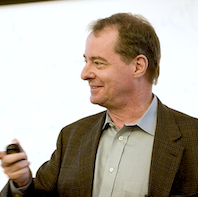
June 4–6, 2012
Organizers
- Robert McCann, University of Toronto
- Pierre-Andre Chiappori, Columbia University
- Scott Duke Kominers, Becker Friedman Research Scholar
This three-day workshop brought together experts in mathematical and economic theory, econometrics, and empirical study of matching to explore the latest theory and a wide array of applications.
In opening remarks, Institute chair Gary S. Becker noted that most economic problems can be looked at as matching problems. “It’s a very important topic,” he said. “Matching theory started in labor markets with simple models. As economists probed more deeply into the theory, they needed more sophisticated mathematics. This is the first conference that I know of that brings together economists and mathematicians to address this matching problem.”
It also was the first joint conference between the Becker Friedman Institute and the Stevanovich Center for Financial Mathematics.
The conference sessions began with tutorials on matching theory and the underlying mathematics, to provide a common knowledge base for scholars from different fields.
John Hatfield of Stanford University began with Gale and Shapely’s work 1962 that explored how marriage matches could be made so that no individual wished for a divorce. Such models are usefully employed in programs that match medical residents with hospitals, school choice systems, labor markets, and auctions, Hatfield said.
In these applications, the “woman” side of the match may take many partners and the relationships take many forms. The quality or success of the relationship or match depends on the specific characteristics offered and desired. "If I’m bidding on baseball card, I want to know more than I’m getting a card. I want to know I’m getting a 1972 Hank Aaron card.’
Becker Friedman Institute Research Scholar Scott Kominers extended the tutorial to explore recent models that go beyond two-sided matches to cases that included intermediaries, multiple partners (or buyers), and transfers of utility. “The main results are that in arbitrary trading networks with multilateral contracts, transferable utility, and concave preferences, these [matching models] work.” He explored implications for cyclic contracts where agents are both buyers and sellers in a manufacturing cycle.
In the next tutorial, conference co-organizer Robert McCann of University of Toronto defined the mathematics of matching and geometry of matching spaces. He showed how optimal transport, which mathematically calculates the most cost-efficient way to distribute mass or materials from one point to another, can be applied to determine the optimal match between buyers and sellers.
Jean Marc Robin of Sciences Po and Robert Shimer of the University of Chicago reviewed literature and theory of search models that help understand labor markets and equilibrium wages. They reviewed partial search models, equilibrium search models, wage posting models. Pierre-Andre Chiappori and Bernard Salanie of Columbia University explored the econometrics of matching in the final tutorial.
Following the tutorials, presentations blended theory with data and real-world applications, highlighting new work that explored topics such as marriage trends, labor markets, and school choice assignments.
Cosponsors
The Stevanovich Center for Financial Mathematics
Program
Monday, June 4
Tutorial 1: Recent Advances in Generalized Matching Theory
- Scott Duke Kominers (Becker Friedman Research Scholar)
- John Hatfield (Stanford University)
- View Slides (.pdf) » | Watch video »
Tutorial 2: Optimal Transportation: From Mathematics to Economics
- Robert McCann (University of Toronto)
- Supplement (.pdf) » | Watch video »
“Matching Markets with Endogenous Information”
- Hao Li (University of British Columbia)
- View Slides (.pdf) »
“Reproductive Capital on the US Marriage Market”
- Corinne Low (Columbia University)
- View Slides (.pdf) »
“Multi-Marginal Optimal Transportation and Hedonic Pricing”
- Brendan Pass (University of Alberta)
- Paper (.pdf) » | Supplement (.pdf) » | View Slides (.pdf) »
“Two-Dimensional Screening: A Useful Optimality Condition”
- Sergei Vieira (IBMEC-RJ)
- Paper (.pdf) » | View Slides (.pdf) »
“Dynamics Converging to Optimal Transport”
- Young-Heon Kim (University of British Columbia)
- View Slides (.pdf) »
“Becker Meets Ricardo: Multisector Matching with Social and Cognitive Skills”
- Xianwen Shi (University of Toronto)
- Paper (.pdf) » | View Slides (.pdf) »
“Interviews and the Assignment of Workers to Jobs”
- Ronald Wolthoff (University of Toronto)
- Paper (.pdf) » | View Slides (.pdf) »
Tuesday, June 5
Tutorial 3: Matching and Search
- Jean Marc Robin (Sciences Po)
- Robert Shimer (University of Chicago)
- View Slides (.pdf) »
Tutorial 4: The Econometrics of Matching
- Pierre-Andre Chiappori (Columbia University)
- Bernard Salanie (Columbia University)
- View Slides (.pdf) »
“Dynamic Marriage Matching: An Empirical Framework”
- Eugene Choo (University of Calgary)
- Paper (.pdf) » | View Slides (.pdf) »
“Unobserved Heterogeneity in Matching Games”
- Jeremy Fox (University of Michigan)
- Paper (.pdf) » | View Slides (.pdf) »
“Using Deferred Acceptance to Measure School Effectiveness: Achievement and Peer Effects in Boston and New York Exam Schools”
- Parag Pathak (Massachusetts Institute of Technology)
- Paper (.pdf) »
“Taxation in Matching Markets”
- Sonia Jaffe (Harvard University)
“Matching, Sorting, Firm Productivity and Wages”
- Costas Meghir (Yale University)
- View Slides (.pdf) »
Wednesday, June 6
“Strategic and Competitive Coalitions”
- Myrna Wooders (Vanderbilt University)
“Promoting School Competition Through School Choice: A Market Design Approach”
- Yusuke Narita (Massachusetts Institute of Technology)
- Paper (.pdf) » | View Slides (.pdf) »
“Cournot-Nash Equilibria and Optimal Transport”
- Guillaume Carlier (Université Paris Dauphine)
- Paper (.pdf) » | View Slides (.pdf) »
“Marriage and Labour Supply”
- Jean Marc Robin (Sciences Po)
- Paper (.pdf) » | View Slides»
“Cupid's Invisible Hand…”
- Bernard Salanie (Columbia University)
- Paper (.pdf) » | View Slides (.pdf) »
“Identification of Multidimensional Hedonic Models”
- Lars Nesheim (University College London)
“Existence in Principal Agent Problems”
- Jeroen Swinkels (Northwestern University)
- Paper (.pdf) » | View Slides (.pdf) »

